Springboot之缓存
缓存缓存其实就是一个临时的存储器。为什么使用缓存客户端第一次请求的时候是从库里拿出我们需要的数据,但如果每次查询都从库里拿,就会很耗时耗能。那么使用缓存以后,我们只需要第一次从库里拿完存到缓存中,只要不清除缓存,我们以后的请求都直接在缓存中拿数据,就会快很多很多。缓存作用**缓存主要是为了提高数据的读取速度。**因为服务器和应用客户端之间存在着流量的瓶颈,所以读取大容量数据时,使用缓存来直接为客户
缓存
缓存其实就是一个临时的存储器。
为什么使用缓存
客户端第一次请求的时候是从库里拿出我们需要的数据,但如果每次查询都从库里拿,就会很耗时耗能。那么使用缓存以后,我们只需要第一次从库里拿完存到缓存中,只要不清除缓存,我们以后的请求都直接在缓存中拿数据,就会快很多很多。
缓存作用
缓存主要是为了提高数据的读取速度。 因为服务器和应用客户端之间存在着流量的瓶颈,所以读取大容量数据时,使用缓存来直接为客户端服务,可以减少客户端与服务器端的数据交互,从而大大提高程序的性能。
Springboot缓存
SpringBoot支持很多种缓存方式:redis、guava、ehcahe、jcache等等。
缓存注解详解
@CacheConfig
主要用于配置该类中会用到的一些共用的缓存配置。 在这里@CacheConfig(cacheNames = “users”):配置了该数据访问对象中返回的内容将存储于名为users的缓存对象中,我们也可以不使用该注解,直接通过@Cacheable自己配置缓存集的名字来定义。
@Cacheable
配置了findByName函数的返回值将被加入缓存。同时在查询时,会先从缓存中获取,若不存在才再发起对数据库的访问。
注解参数:
- value、cacheNames:两个等同的参数(cacheNames为Spring 4新增,作为value的别名),用于指定缓存组件的名字,数组形式。由于Spring 4中新增了@CacheConfig,因此在Spring 3中原本必须有的value属性,也成为非必需项了
- key:缓存对象存储在Map集合中的key值,非必需,缺省按照函数的所有参数组合作为key值,若自己配置需使用SpEL表达式,比如:编写SpEL; #id,参数id的值 ,,#a0(第一个参数), #p0(和a0的一样的意义) ,#root.args[0]
- condition:缓存对象的条件,非必需,也需使用SpEL表达式,只有满足表达式条件的内容才会被缓存,比如:@Cacheable(key = “#p0”, condition = “#p0.length() < 3”),表示只有当第一个参数的长度小于3的时候才会被缓存,若做此配置上面的AAA用户就不会被缓存,读者可自行实验尝试。
- unless:另外一个缓存条件参数,非必需,需使用SpEL表达式。它不同于condition参数的地方在于它的判断时机,该条件是在函数被调用之后才做判断的,所以它可以通过对result进行判断。
- keyGenerator:用于指定key生成器,非必需。若需要指定一个自定义的key生成器,我们需要去实现org.springframework.cache.interceptor.KeyGenerator接口,并使用该参数来指定。需要注意的是:key/keyGenerator:二选一使用;不能同时使用
- cacheManager:用于指定使用哪个缓存管理器,非必需。只有当有多个时才需要使用
- cacheResolver:用于指定使用那个缓存解析器,非必需。需通过org.springframework.cache.interceptor.CacheResolver接口来实现自己的缓存解析器,并用该参数指定。
- sync:是否使用异步模式
@CachePut
配置于函数上,能够根据参数定义条件来进行缓存,它与@Cacheable不同的是,它每次都会真是调用函数,所以主要用于数据新增和修改操作上。 它的参数与@Cacheable类似,具体功能可参考上面对@Cacheable参数的解析
@CacheEvict
配置于函数上,通常用在删除方法上,用来从缓存中移除相应数据。也就是清除缓存除了同@Cacheable一样的参数之外,它还有下面两个参数:
- allEntries:非必需,默认为false。当为true时,会移除所有数据
- beforeInvocation:非必需,**默认为false,会在调用方法之后移除数据。**当为true时,会在调用方法之前移除数据。
@Caching注解
用于定义复杂的缓存规则,可以集成@Cacheable和 @CachePut
// @Caching 定义复杂的缓存规则
@Caching(
cacheable = {
@Cacheable(/*value={"emp"},*/key = "#lastName")
},
put = {
@CachePut(/*value={"emp"},*/key = "#result.id"),
@CachePut(/*value={"emp"},*/key = "#result.email")
}
)
public Employee getEmpByLastName(String lastName){
return employeeMapper.getEmpByLastName(lastName);
}
SpEL表达式用法

Spring Boot 整合 Ehcache
什么是Ehcache?
Java缓存框架 EhCache EhCache 是一个纯Java的进程内缓存框架,具有快速、精干等特点,是Hibernate中默认的CacheProvider。
主要面向通用缓存,Java EE和轻量级容器。它具有内存和磁盘存储,缓存加载器,缓存扩展,缓存异常处理程序,一个gzip缓存servlet过滤器,支持REST和SOAP api等特点。
整合步骤
1、修改 pom 文件
引入Ehcache jar包
<!-- Ehcache 坐标 -->
<dependency>
<groupId>net.sf.ehcache</groupId>
<artifactId>ehcache</artifactId>
</dependency>
2、创建 Ehcache 的配置文件
文件名:ehcache.xml
位置:src/main/resources/ehcache.xml
<ehcache xmlns:xsi="http://www.w3.org/2001/XMLSchema-instance"
xsi:noNamespaceSchemaLocation="../config/ehcache.xsd">
<diskStore path="java.io.tmpdir" />
<!--defaultCache:echcache 的默认缓存策略 -->
<defaultCache maxElementsInMemory="10000" eternal="false"
timeToIdleSeconds="120" timeToLiveSeconds="120"
maxElementsOnDisk="10000000" diskExpiryThreadIntervalSeconds="120"
memoryStoreEvictionPolicy="LRU">
<persistence strategy="localTempSwap" />
</defaultCache>
<!-- 自定义缓存策略 -->
<cache name="users" maxElementsInMemory="10000" eternal="false"
timeToIdleSeconds="120" timeToLiveSeconds="120"
maxElementsOnDisk="10000000" diskExpiryThreadIntervalSeconds="120"
memoryStoreEvictionPolicy="LRU">
<persistence strategy="localTempSwap" />
</cache>
</ehcache>
3、修改 application.properties 文件
主要添加 ehcache 的配置xml文件的位置
spring.cache.ehcache.cofnig=ehcache.xml
4、修改启动类
启动类上在增加 @EnableCaching,作用就是启动 SpringCache 功能,使缓存生效 。
5、在service业务层用注解来使用缓存
也可以在dao层使用注解,使用方式一样。注意:这里就算不调用查询数据库的方法,service层的方法返回值也会被缓存,也就是该缓存注解缓存的是方法的返回值,与方法里的执行逻辑无关。
@Service
public class UsersServiceImpl implements UsersService {
@Autowired
private UsersRepository usersRepository;
@Override
// @Cacheable:对当前查询的对象做缓存处理
@Cacheable(value = "users")
public Users findUserById(Integer id) {
return this.usersRepository.findOne(id);
}
Springboot整合Redis
整合步骤
1、引入依赖 pom.xml
<dependency>
<groupId>org.springframework.boot</groupId>
<artifactId>spring-boot-starter-data-redis</artifactId>
</dependency>
2、修改application.yml,配置redis
#数据库连接
spring:
datasource:
url: jdbc:mysql://localhost:3306/mytest_springboot_cache?useUnicode=true
driver-class-name: com.mysql.jdbc.Driver
username: root
password: lzh
## Redis 配置
redis:
## Redis数据库索引(默认为0)
database: 0
## Redis服务器地址
host: 192.168.126.129
## Redis服务器连接端口
port: 6379
## Redis服务器连接密码(默认为空)
password:
jedis:
pool:
## 连接池最大连接数(使用负值表示没有限制)
#spring.redis.pool.max-active=8
max-active: 8
## 连接池最大阻塞等待时间(使用负值表示没有限制)
#spring.redis.pool.max-wait=-1
max-wait: -1
## 连接池中的最大空闲连接
#spring.redis.pool.max-idle=8
max-idle: 8
## 连接池中的最小空闲连接
#spring.redis.pool.min-idle=0
min-idle: 0
## 连接超时时间(毫秒)
timeout: 1200
3、编写java配置类
@Configuration
@EnableCaching
public class RedisConfig extends CachingConfigurerSupport {
/**
* 选择redis作为默认缓存工具
* @param redisConnectionFactory
* @return
*/
/*@Bean
//springboot 1.xx
public CacheManager cacheManager(RedisTemplate redisTemplate) {
RedisCacheManager rcm = new RedisCacheManager(redisTemplate);
return rcm;
}*/
@Bean
public CacheManager cacheManager(RedisConnectionFactory redisConnectionFactory) {
RedisCacheConfiguration redisCacheConfiguration = RedisCacheConfiguration.defaultCacheConfig()
.entryTtl(Duration.ofHours(1)); // 设置缓存有效期一小时
return RedisCacheManager
.builder(RedisCacheWriter.nonLockingRedisCacheWriter(redisConnectionFactory))
.cacheDefaults(redisCacheConfiguration).build();
}
/**
* retemplate相关配置
* @param factory
* @return
*/
@Bean
public RedisTemplate<String, Object> redisTemplate(RedisConnectionFactory factory) {
RedisTemplate<String, Object> template = new RedisTemplate<>();
// 配置连接工厂
template.setConnectionFactory(factory);
//使用Jackson2JsonRedisSerializer来序列化和反序列化redis的value值(默认使用JDK的序列化方式)
Jackson2JsonRedisSerializer jacksonSeial = new Jackson2JsonRedisSerializer(Object.class);
ObjectMapper om = new ObjectMapper();
// 指定要序列化的域,field,get和set,以及修饰符范围,ANY是都有包括private和public
om.setVisibility(PropertyAccessor.ALL, JsonAutoDetect.Visibility.ANY);
// 指定序列化输入的类型,类必须是非final修饰的,final修饰的类,比如String,Integer等会跑出异常
om.enableDefaultTyping(ObjectMapper.DefaultTyping.NON_FINAL);
jacksonSeial.setObjectMapper(om);
// 值采用json序列化
template.setValueSerializer(jacksonSeial);
//使用StringRedisSerializer来序列化和反序列化redis的key值
template.setKeySerializer(new StringRedisSerializer());
// 设置hash key 和value序列化模式
template.setHashKeySerializer(new StringRedisSerializer());
template.setHashValueSerializer(jacksonSeial);
template.afterPropertiesSet();
return template;
}
/**
* 对hash类型的数据操作
*
* @param redisTemplate
* @return
*/
@Bean
public HashOperations<String, String, Object> hashOperations(RedisTemplate<String, Object> redisTemplate) {
return redisTemplate.opsForHash();
}
/**
* 对redis字符串类型数据操作
*
* @param redisTemplate
* @return
*/
@Bean
public ValueOperations<String, Object> valueOperations(RedisTemplate<String, Object> redisTemplate) {
return redisTemplate.opsForValue();
}
/**
* 对链表类型的数据操作
*
* @param redisTemplate
* @return
*/
@Bean
public ListOperations<String, Object> listOperations(RedisTemplate<String, Object> redisTemplate) {
return redisTemplate.opsForList();
}
/**
* 对无序集合类型的数据操作
*
* @param redisTemplate
* @return
*/
@Bean
public SetOperations<String, Object> setOperations(RedisTemplate<String, Object> redisTemplate) {
return redisTemplate.opsForSet();
}
/**
* 对有序集合类型的数据操作
*
* @param redisTemplate
* @return
*/
@Bean
public ZSetOperations<String, Object> zSetOperations(RedisTemplate<String, Object> redisTemplate) {
return redisTemplate.opsForZSet();
}
}
这里主要是使用RedisTemplate来对远程redis操作,每次访问controller暴露的接口,首先判断redis缓存中是否存在该数据,若不存在就从数据库中读取数据,然后保存到redis缓存中,当下次访问的时候,就直接从缓存中取出来。这样就不用每次都执行sql语句,能够提高访问速度。 但是在保存数据到缓存中,通过设置键和值和超时删除,注意设置超时删除缓存时间不要太长,否则会给服务器带来压力。
也可以使用注解的形式,使用方式和Ehcache的使用方式一致。
Springboot整合redis集群
这里不介绍redis集群,详细见redis类型的博客。
不指定redis连接池
yml配置文件:
spring:
redis:
cluster:
nodes:
- 192.168.1.236:7001
- 192.168.1.236:7002
- 192.168.1.236:7003
- 192.168.1.244:7004
- 192.168.1.244:7005
- 192.168.1.244:7006
max-redirects: 3 # 获取失败 最大重定向次数
pool:
max-active: 1000 # 连接池最大连接数(使用负值表示没有限制)
max-idle: 10 # 连接池中的最大空闲连接
max-wait: -1 # 连接池最大阻塞等待时间(使用负值表示没有限制)
min-idle: 5 # 连接池中的最小空闲连接
timeout: 6000 # 连接超时时长(毫秒)
这种方式 redisTemplate 可直接使用默认,在使用的地方直接注入即可
@Autowired
private RedisTemplate<String, Object> redisTemplate;
使用jedis连接池
yml配置文件:
spring:
redis:
password: # 密码(默认为空)
timeout: 6000ms # 连接超时时长(毫秒)
cluster:
nodes:
- 192.168.1.236:7001
- 192.168.1.236:7002
- 192.168.1.236:7003
- 192.168.1.244:7004
- 192.168.1.244:7005
- 192.168.1.244:7006
jedis:
pool:
max-active: 1000 # 连接池最大连接数(使用负值表示没有限制)
max-wait: -1ms # 连接池最大阻塞等待时间(使用负值表示没有限制)
max-idle: 10 # 连接池中的最大空闲连接
min-idle: 5 # 连接池中的最小空闲连接
连接池注入配置信息
@Configuration
public class RedisConfig {
@Autowired
private RedisConnectionFactory factory;
@Bean
public RedisTemplate<String, Object> redisTemplate() {
RedisTemplate<String, Object> redisTemplate = new RedisTemplate<>();
redisTemplate.setKeySerializer(new StringRedisSerializer());
redisTemplate.setHashKeySerializer(new StringRedisSerializer());
redisTemplate.setHashValueSerializer(new StringRedisSerializer());
redisTemplate.setValueSerializer(new StringRedisSerializer());
redisTemplate.setConnectionFactory(factory);
return redisTemplate;
}
}
在使用的地方直接注入即可
@Autowired
private RedisTemplate<String, Object> redisTemplate;
使用lettuce连接池(推荐)
yml配置文件:
spring:
redis:
timeout: 6000ms
password:
cluster:
max-redirects: 3 # 获取失败 最大重定向次数
nodes:
- 192.168.1.236:7001
- 192.168.1.236:7002
- 192.168.1.236:7003
- 192.168.1.244:7004
- 192.168.1.244:7005
- 192.168.1.244:7006
lettuce:
pool:
max-active: 1000 #连接池最大连接数(使用负值表示没有限制)
max-idle: 10 # 连接池中的最大空闲连接
min-idle: 5 # 连接池中的最小空闲连接
max-wait: -1 # 连接池最大阻塞等待时间(使用负值表示没有限制)
连接池注入配置信息
@Configuration
@AutoConfigureAfter(RedisAutoConfiguration.class)
public class RedisConfig {
@Bean
public RedisTemplate<String, Object> redisCacheTemplate(LettuceConnectionFactory redisConnectionFactory) {
RedisTemplate<String, Object> template = new RedisTemplate<>();
template.setKeySerializer(new StringRedisSerializer());
template.setValueSerializer(new GenericJackson2JsonRedisSerializer());
template.setConnectionFactory(redisConnectionFactory);
return template;
}
}
在使用的地方直接注入即可
@Autowired
private RedisTemplate<String, Object> redisTemplate;
更多推荐
 已为社区贡献4条内容
已为社区贡献4条内容









所有评论(0)